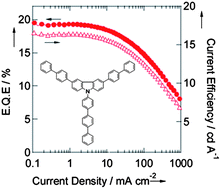New carbazole-based host material for low-voltage and highly efficient red phosphorescent organic light-emitting diodes†‡
Abstract
A new

* Corresponding authors
a Department of Electronic Engineering, Dong-A University, Busan, Republic of Korea
b Unitech Co., Ltd., Ansan-city, Gyeonggi-do, Republic of Korea
c
School of Electrical and Computer Engineering, Inter-University Semiconductor Research Center, Seoul National University, Seoul, Republic of Korea
E-mail:
chlee7@snu.ac.kr
Fax: +82-2-877-6668
d Department of Chemical and Biomolecular Engineering, Electronic Material Lab, Yonsei University, Seoul, Republic of Korea
e
School of Chemical and Biological Engineering, Intelligent Hybrids Research Center, Seoul National University, Seoul, Republic of Korea
E-mail:
khchar@snu.ac.kr
A new

 Please wait while we load your content...
Something went wrong. Try again?
Please wait while we load your content...
Something went wrong. Try again?
J. Kwak, Y. Lyu, H. Lee, B. Choi, K. Char and C. Lee, J. Mater. Chem., 2012, 22, 6351 DOI: 10.1039/C2JM15138C
To request permission to reproduce material from this article, please go to the Copyright Clearance Center request page.
If you are an author contributing to an RSC publication, you do not need to request permission provided correct acknowledgement is given.
If you are the author of this article, you do not need to request permission to reproduce figures and diagrams provided correct acknowledgement is given. If you want to reproduce the whole article in a third-party publication (excluding your thesis/dissertation for which permission is not required) please go to the Copyright Clearance Center request page.
Read more about how to correctly acknowledge RSC content.
 Fetching data from CrossRef.
Fetching data from CrossRef.
This may take some time to load.
Loading related content
